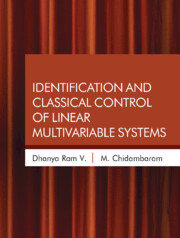Book contents
- Frontmatter
- Contents
- Preface
- Acknowledgements
- List of Abbreviations
- Notations
- 1 Models, Control Theory, and Examples
- 2 Identification and Control of SISO Systems
- 3 Introduction to Linear Multivariable Systems
- 4 CRC Method for Identifying TITO Systems
- 5 CRC Method for Identifying SISO Systems by CSOPTD Models
- 6 CRC Method for Identifying TITO Systems by CSOPTD Models
- 7 Identification of StableMIMO System by Optimization Method
- 8 Identification of Centralized ControlledMultivariable Systems
- 9 Identification of Multivariable SOPTD Models by Optimization Method
- 10 Identification of Unstable TITO Systems by Optimization Technique
- 11 Centralized PI Controllers Based on Steady State Gain Matrix
- 12 SSGM Identification and Control of Unstable Multivariable Systems
- 13 Control of Stable Non-square MIMO Systems
- 14 Control of Unstable Non-square Systems
- 15 Trends in Control ofMultivariable Systems
- Appendix A Identification of Unstable Second Order Transfer Function Model with a Zero by Optimization Method
- Appendix B For Chapter 3
- Appendix C For Chapter 7
- Bibliography
- Index
2 - Identification and Control of SISO Systems
Published online by Cambridge University Press: 31 July 2022
- Frontmatter
- Contents
- Preface
- Acknowledgements
- List of Abbreviations
- Notations
- 1 Models, Control Theory, and Examples
- 2 Identification and Control of SISO Systems
- 3 Introduction to Linear Multivariable Systems
- 4 CRC Method for Identifying TITO Systems
- 5 CRC Method for Identifying SISO Systems by CSOPTD Models
- 6 CRC Method for Identifying TITO Systems by CSOPTD Models
- 7 Identification of StableMIMO System by Optimization Method
- 8 Identification of Centralized ControlledMultivariable Systems
- 9 Identification of Multivariable SOPTD Models by Optimization Method
- 10 Identification of Unstable TITO Systems by Optimization Technique
- 11 Centralized PI Controllers Based on Steady State Gain Matrix
- 12 SSGM Identification and Control of Unstable Multivariable Systems
- 13 Control of Stable Non-square MIMO Systems
- 14 Control of Unstable Non-square Systems
- 15 Trends in Control ofMultivariable Systems
- Appendix A Identification of Unstable Second Order Transfer Function Model with a Zero by Optimization Method
- Appendix B For Chapter 3
- Appendix C For Chapter 7
- Bibliography
- Index
Summary
In this chapter, basics of open loop and closed loop identification methods of transfer function models of Single Input Single Output (SISO) systems are reviewed. Open loop identification methods are proposed to identify the parameters of First Order Plus Time Delay (FOPTD) model and Critically Damped Second Order Plus Time Delay (CSOPTD) model. The methods under closed loop identification include the reaction curve method and the optimization method. A review of these methods is given in this chapter. Methods of designing PI controllers for transfer function models for SISO systems are brought out.
Identification of SISO Systems
Process identification is the method of obtaining a model which can be used to predict the behaviour of the process output for a given process input. Transfer function model identification is important for the design of controllers. Identification can be carried out in an open loopmanner or in a closed loopmanner. Excellent books are available for process identification (Ljung, 1998; Soderstrom and Stoica, 1989;Wang et al., 2008; Sung et al., 2009). Pintelon and Schoukens (2001) have given an excellent description of the methods of system identification from the data represented in frequency domain. Clark (2005) plotted the normalized step response curve in time domain for second order systems and third order systems for different damping ratios. These graphs can be used for the estimation of model parameters. Keesman (2011) has given an excellent account of the method available for system identification based on the discrete time models.
Open Loop Identification of Stable Systems
In open loop identification of the system, for a given change in the input variable, the change in output response is noted. The block diagram of the open loop identification is shown in Fig. 2.1. Many works have been reported on open loop identification methods. Identification of a FOPTD model is adequate for design of Proportional Integral Derivative (PID) controllers. Sundaresan and Krishnaswamy (1978) (SK method) presented a reaction curve method for process identification of FOPTD models. Sundaresan et al. (1978) pointed out the error sensitivity involved in the inflection point in the graphical method and suggested a new method of parameter estimation for non-oscillatory, oscillatory, and systems with delay, which involves utilizing the first moment of the step response curve.
- Type
- Chapter
- Information
- Publisher: Cambridge University PressPrint publication year: 2023



